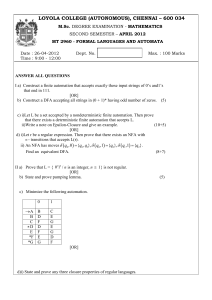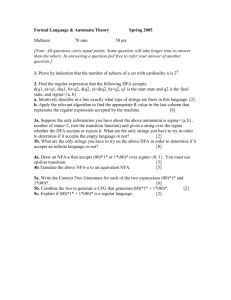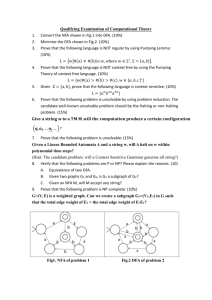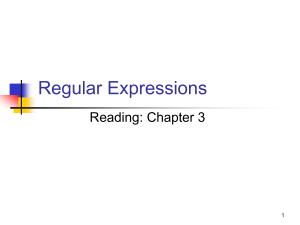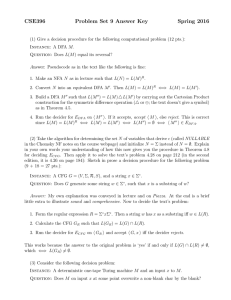Example sheet 3
advertisement
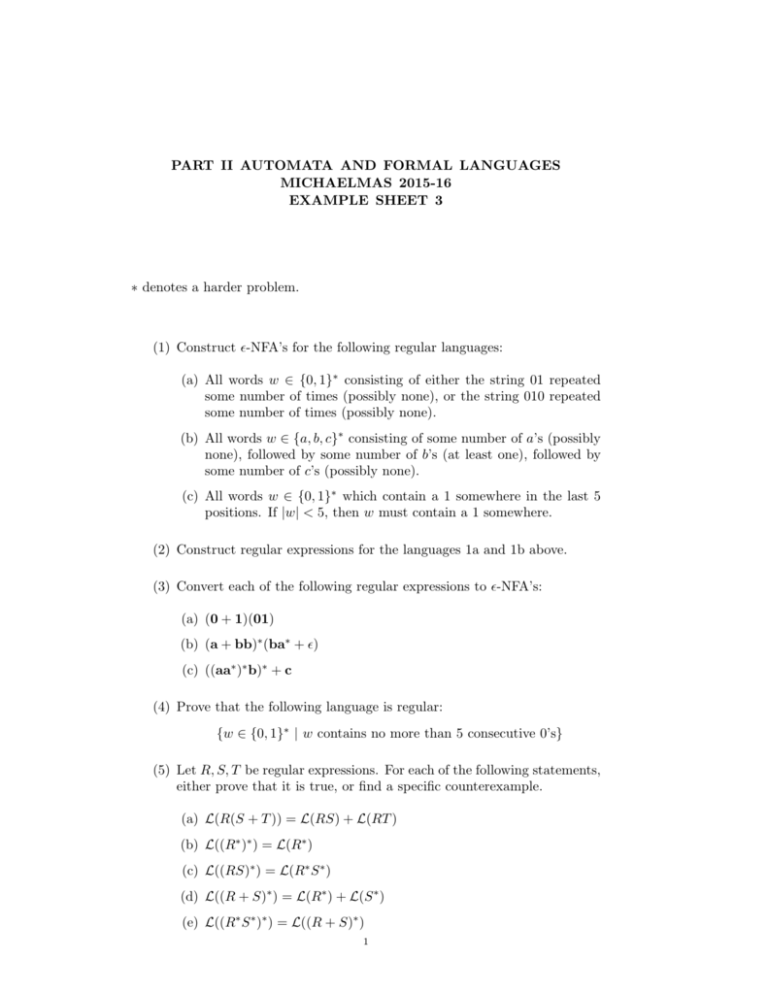
PART II AUTOMATA AND FORMAL LANGUAGES
MICHAELMAS 2015-16
EXAMPLE SHEET 3
∗ denotes a harder problem.
(1) Construct -NFA’s for the following regular languages:
(a) All words w ∈ {0, 1}∗ consisting of either the string 01 repeated
some number of times (possibly none), or the string 010 repeated
some number of times (possibly none).
(b) All words w ∈ {a, b, c}∗ consisting of some number of a’s (possibly
none), followed by some number of b’s (at least one), followed by
some number of c’s (possibly none).
(c) All words w ∈ {0, 1}∗ which contain a 1 somewhere in the last 5
positions. If |w| < 5, then w must contain a 1 somewhere.
(2) Construct regular expressions for the languages 1a and 1b above.
(3) Convert each of the following regular expressions to -NFA’s:
(a) (0 + 1)(01)
(b) (a + bb)∗ (ba∗ + )
(c) ((aa∗ )∗ b)∗ + c
(4) Prove that the following language is regular:
{w ∈ {0, 1}∗ | w contains no more than 5 consecutive 0’s}
(5) Let R, S, T be regular expressions. For each of the following statements,
either prove that it is true, or find a specific counterexample.
(a) L(R(S + T )) = L(RS) + L(RT )
(b) L((R∗ )∗ ) = L(R∗ )
(c) L((RS)∗ ) = L(R∗ S ∗ )
(d) L((R + S)∗ ) = L(R∗ ) + L(S ∗ )
(e) L((R∗ S ∗ )∗ ) = L((R + S)∗ )
1
2
EXAMPLE SHEET 3
(6) Use the pumping lemma to show that none of the following languages
are regular:
(a) {an bn | n ≥ 0}
(b) {a2n b2n | n ≥ 0}
(c) {ww | w ∈ {0, 1}∗ }
(7) For each of the following languages, determine whether or not they are
regular. Justify your answers.
(a) {an b2n | n ≥ 0}
(b) {an bm | n 6= m}
(c) {xcx | x ∈ {a, b}∗ }
(d) {xcy | x, y ∈ {a, b}∗ }
(e) L((a∗ b)∗ a∗ )
(f) {an bm | n > m}
(g) {an bn+100 | n ≥ 0}
(h) {an bm | n ≥ m and m ≤ 1000}
(i) {an bm | n ≥ m and m ≥ 1000}
(8) Prove that no infinite subset of {0n 1n | n ≥ 0} is a regular language.
(9) Let D be a DFA with N states. Prove the following:
(a) If D accepts at least one word, then D accepts a word of length
less than N .
(b) If D accepts at least one word of length ≥ N , then D accepts
infinitely many words.
(10) Is the following language regular:
{1p | p is a prime }
Justify your answer.
(11*) Is there an algorithm which takes as input a DFA D and decides whether
or not L(D) is empty? If so, describe such an algorithm; if not, explain
why not.
(12*) For any X ⊆ {1}∗ , show that X ∗ is a regular language.


